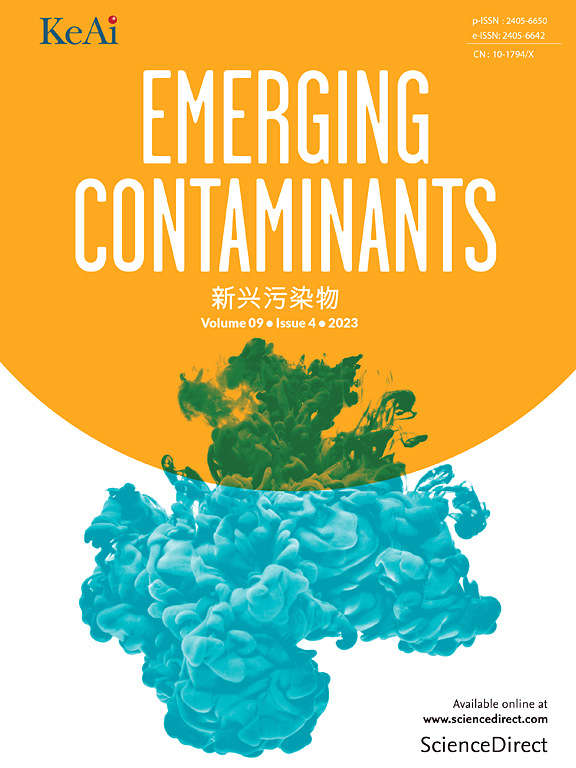多氯联苯在人体内富集及对甲状腺激素受体β1的干扰
IF 6.9
2区 环境科学与生态学
Q1 ENVIRONMENTAL SCIENCES
引用次数: 0
摘要
多氯联苯(PCBs)是一种持久性有机污染物,以其生物蓄积性和毒性而闻名。虽然多氯联苯的生产和使用在几十年前就在世界范围内被禁止,但由于多氯联苯的环境持久性和无意生产,它仍然构成健康风险。本报告调查了中国东部城市居民血清中多氯联苯浓度和时间趋势。多氯联苯的内分泌干扰电位也进行了研究,特别是对甲状腺激素受体的影响。通过对5年数据的分析,结果表明,类二恶英多氯联苯及其同系物PCB209浓度维持在较低水平,且无明显的时间变化趋势,但指标多氯联苯特别是PCB52、PCB153和PCB180浓度呈上升趋势。此外,为了评估多氯联苯与甲状腺激素受体TRβ1的结合,进行了分子对接模拟。研究发现,PCB28、PCB52和PCB153的多氯联苯可以干扰三碘甲状腺原氨酸与TRβ1的结合,其影响与多溴联苯BB-153的影响相当,多溴联苯是一种已知的甲状腺功能干扰物。此外,PCB180与TRβ1的结合比BB-153更强。我们的研究结果表明,持续监测人体暴露于PCB28、PCB52、PCB153和PCB180,并详细评估甲状腺功能干扰是必要的。本文章由计算机程序翻译,如有差异,请以英文原文为准。

Revisiting polychlorinated biphenyls enriching in human and disrupting of thyroid hormone receptor β1
Polychlorinated biphenyls (PCBs) are persistent organic pollutants renowned for their bioaccumation and toxicity. Although PCBs production and use were banned worldwide decades ago, PCBs still pose a health risk due to their environmental persistence and unintentional production. In this report, PCB concentrations and temporal trends in serum from residents of urban areas in eastern China is investigated. The endocrine-disrupting potentials of PCBs are also investigated, particularly effects on thyroid hormone receptors. Through analysis of five years of data, results indicated that dioxin-like PCBs and congener PCB209 concentrations maintained low and had no marked temporal trends, but that the indicator PCBs and particularly PCB52, PCB153, and PCB180 concentrations increased. Furthermore, to evaluate binding of PCBs to the thyroid hormone receptor TRβ1, molecular docking simulations are performed. It is found that the PCBs of PCB28, PCB52, and PCB153 can interfere with triiodothyronine binding to TRβ1, which are comparable to the effects of the polybrominated biphenyl BB-153, a known thyroid function disruptor. What's more, the PCB180 binds to TRβ1 more strongly than that of BB-153. Our results indicated that a continuously monitoring of human exposures to PCB28, PCB52, PCB153, PCB180, and a detailed assessment of thyroid function interference is necessary.
求助全文
通过发布文献求助,成功后即可免费获取论文全文。
去求助
来源期刊

Emerging Contaminants
Medicine-Public Health, Environmental and Occupational Health
CiteScore
10.00
自引率
6.70%
发文量
35
审稿时长
44 days
期刊介绍:
Emerging Contaminants is an outlet for world-leading research addressing problems associated with environmental contamination caused by emerging contaminants and their solutions. Emerging contaminants are defined as chemicals that are not currently (or have been only recently) regulated and about which there exist concerns regarding their impact on human or ecological health. Examples of emerging contaminants include disinfection by-products, pharmaceutical and personal care products, persistent organic chemicals, and mercury etc. as well as their degradation products. We encourage papers addressing science that facilitates greater understanding of the nature, extent, and impacts of the presence of emerging contaminants in the environment; technology that exploits original principles to reduce and control their environmental presence; as well as the development, implementation and efficacy of national and international policies to protect human health and the environment from emerging contaminants.
 求助内容:
求助内容: 应助结果提醒方式:
应助结果提醒方式:


